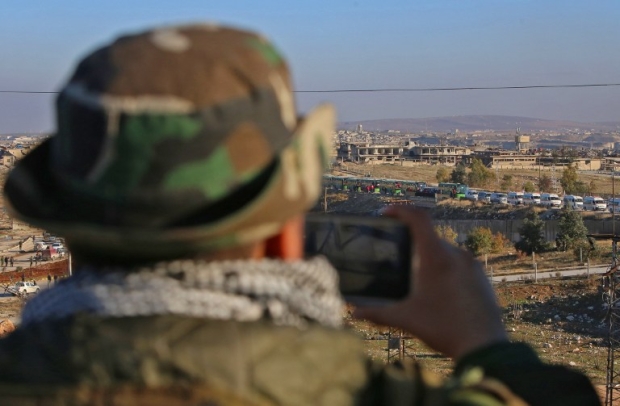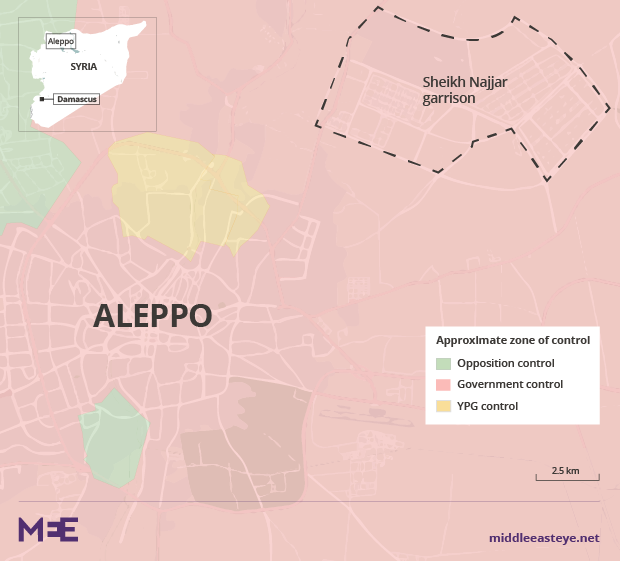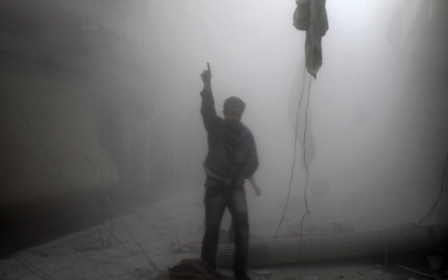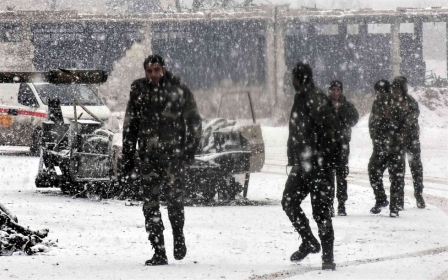Iran opposition group says Tehran responsible for fall of Aleppo

Iran’s Islamic Revolutionary Guard Corps (IRGC) has played a significant role in retaking Aleppo from rebel fighters, a report by an Iranian opposition group says.
“The forces that occupied Aleppo were actually the IRGC and foreign mercenaries under their command," said Shahin Gobadi, a member of the National Council of Resistance of Iran (NCRI), in a video conference widely circulated on Wednesday.
Gobadi identified the Lebanese Hezbollah, Iraqi militias, the Afghan Fatimiyoun militias and the Pakistani Zeynabiyoun militias as the main forces under IRGC command in Aleppo.
The NCRI is part of the People’s Mujahiden of Iran or MEK, an armed opposition group to the Iranian government which is considered a terrorist organisation by Tehran and ally Iraq. The video seems to have been a follow-up to a report collated by the MEK and released to The Washington Times on Tuesday.
The MEK was previously designated as a terrorist group by Washington and London but also has allies among US Republican groups and hardline opponents of Tehran in the US. It has previously revealed attempts by Iran to hide nuclear weapons-related facilities from UN inspectors.
How opposition collated report
For this report, the MEK relied on its network of spies inside the government and IRGC to paint a picture of Iran’s deep military involvement in the Syrian conflict.
“The fact is that Aleppo has been occupied by the IRGC and its mercenaries,” MEK told The Washington Times on Tuesday. “Mass executions, preventing the transfer of civilians, including women and children, [and] attacking civilians has all been done by the forces of the mullah’s regime.”
According to the report: “The obstruction to the transfer of residents out of Aleppo and the two incidents of the killing of residents over two consecutive days were perpetuated by the IRGC and their mercenaries,” said Gobadi.
A convoy of about 800 people was taken hostage and four people were killed at a Hezbollah checkpoint near Ramoussah on Friday, according to MEK. The situation was repeated in a similar incident on Tuesday when a convoy leaving Aleppo was stalled for nearly 24 hours amid delays in the evacuation of the two Shia villages of Foua and Kefraya in Idlib province.
East Aleppo evacuation resumes in Syria as snow hits
A Syrian military source told AFP that the delays in evacuation from Aleppo were “procedural” and connected with the need to “synchronise” operations in the two villages.
Iranian bases around Aleppo
The MEK report on Syria identifies Iranian leaders in Aleppo, the locations of bases, the foreign militias doing the killing and how Iran pays them.
It said the IRGC had amassed an army of 25,000 troops in and around Aleppo, as well as establishing a network of bases around the city to direct the battle.
In the video, Gobadi claimed that the Iranian government divided Syria into five command centres, with the operation in Aleppo being carried out by a northern command centre in an area called the Sheikh Najjar garrison northeast of Aleppo.
But the main headquarters of the IRGC, according to the report, is at Fort Behuth, 20 miles south of Aleppo.
Also based at the headquarters were Lebanese Hezbollah militia forces and fighters from the Iraqi Shia militia Hashd al-Shaabi, also known as the Popular Mobilisation Units (PMU), who were heavily involved in the operation to retake Aleppo as well.
In October, Ahmed al-Asadi, a spokesman for the PMU, told a news conference in Baghdad that the Shia militia was prepared to fight alongside forces loyal to Assad.
The report also identified the man in charge of the operation as Javad Qadiri, a veteran commander of the IRGC who has been in Syria for the past three years and is also close to Qassem Soleimani, commander in chief of the Quds Force, the IRGC unit in charge of Iran’s foreign military operations.
According to the report, Qadiri met with Syrian President Bashar al-Assad and Hezbollah leader Hassan Nasrallah several times this year.
Iranian presence in Syria
Iranian leaders claimed a military victory in Aleppo, with Supreme Leader Ayatollah Ali Khamenei’s chief military aide boasting that Assad’s forces would have been unable to retake the besieged city without support from Tehran.
“Aleppo was liberated thanks to a coalition between Iran, Syria, Russia and Lebanon’s Hezbollah,” said Seyed Yahya Rahim-Safavi. “Iran is on one side of this coalition which is approaching victory and this has shown our strength.”
'Wait until the harvest': Leading figures in Iran, Lebanon warn of Aleppo fallout
Meanwhile, the report claimed Syrian government forces are scarce around Aleppo, and that it was Iran doing the lion’s share of offensive manoeuvres.
At the same time, Soleimani was seen in Aleppo during the evacuation of residents from the besieged enclave.
Furthermore, Iran confirmed in November the death of more than 1,000 fighters sent to Syria to support Assad's army.
The Institute for the Study of War, a nonprofit research group in Washington, has reported that Iran organised Shia militias in Iraq, not only to fight the Islamic State there but also to deploy them against the rebel forces in Aleppo.
New MEE newsletter: Jerusalem Dispatch
Sign up to get the latest insights and analysis on Israel-Palestine, alongside Turkey Unpacked and other MEE newsletters
Middle East Eye delivers independent and unrivalled coverage and analysis of the Middle East, North Africa and beyond. To learn more about republishing this content and the associated fees, please fill out this form. More about MEE can be found here.







